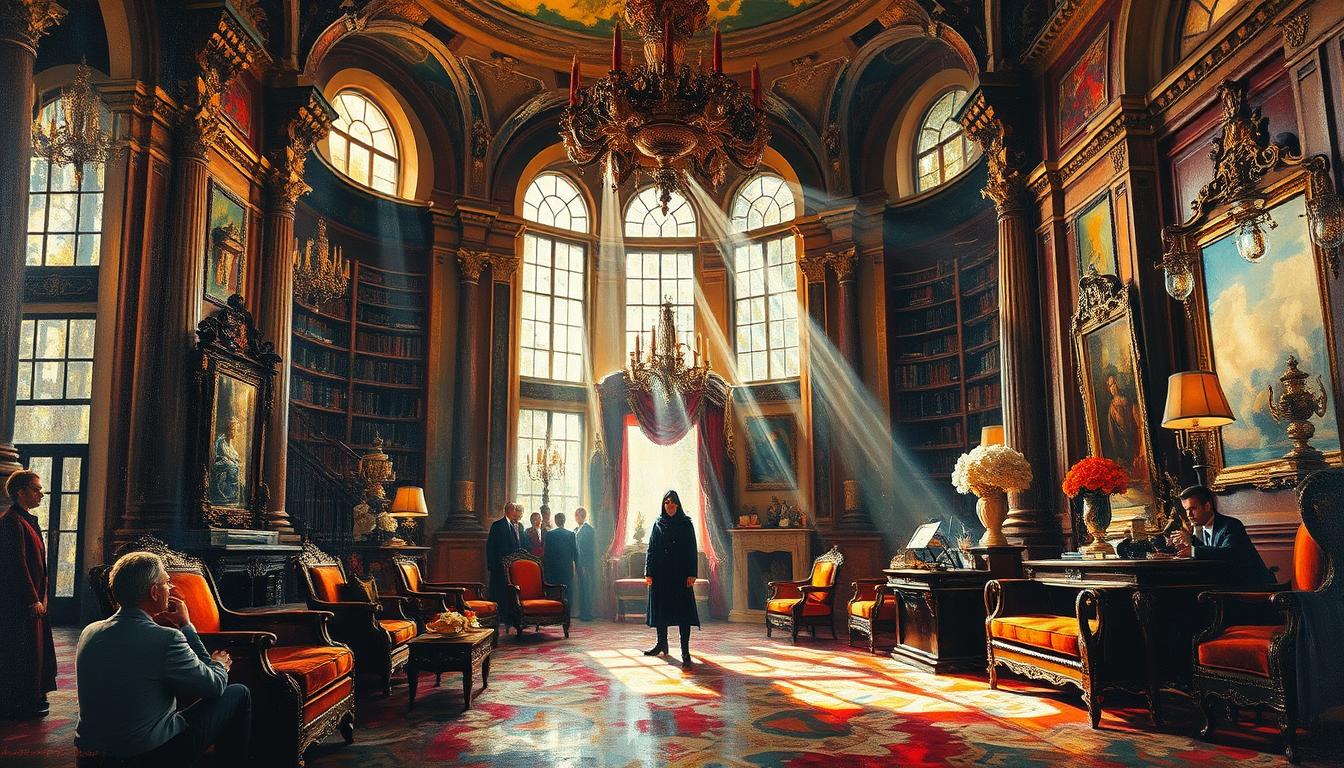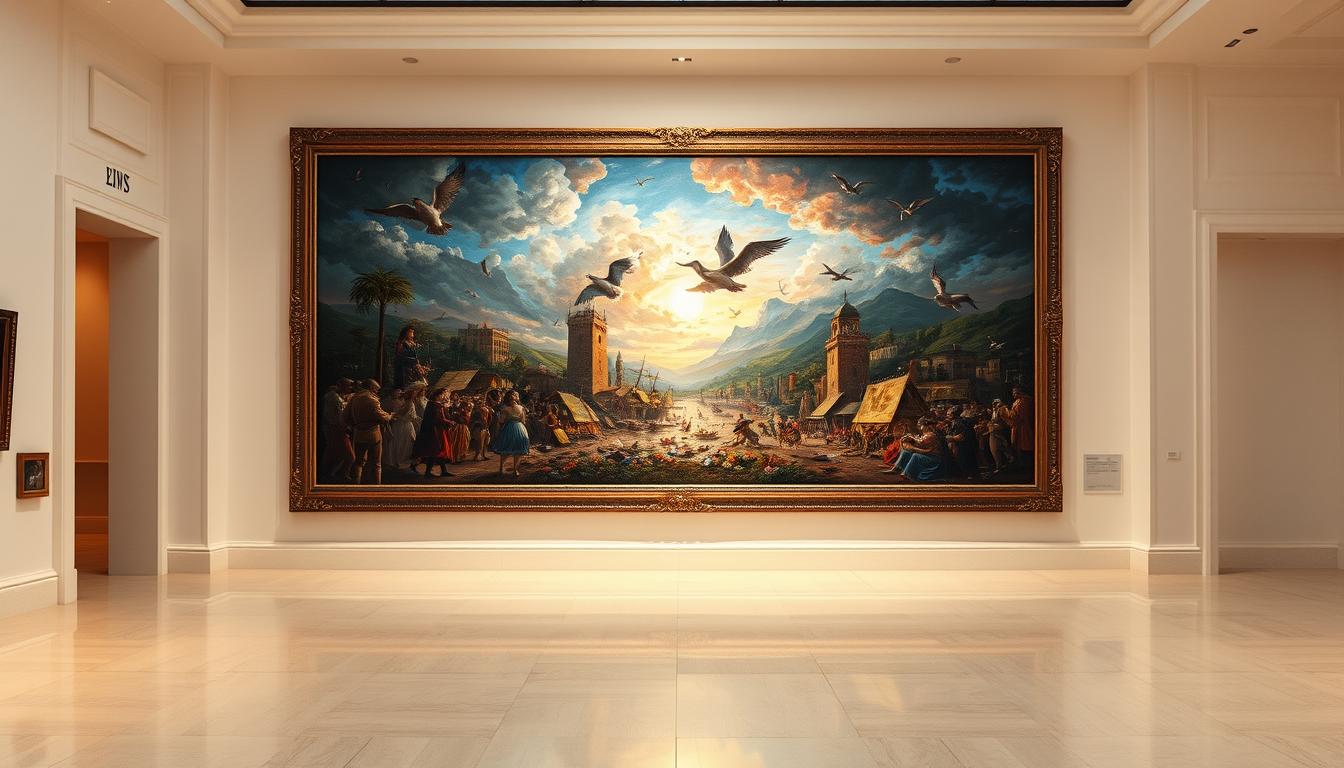Quick answer for UK readers: the headline “$70 million” sits inside a bigger New York story. At Christie’s New York, David Hockney’s Portrait of an Artist (Pool with Two Figures) surged past that level and finally fetched $90.3m including buyer’s premium.
This article will explain the sale, the short bidding duel between phone bidders, and why this 1972 canvas set a new auction record for a living artist.
The piece is one of Hockney’s most recognisable works, with a backstory tied to studio photographs and high-profile provenance from David Geffen to Joe Lewis.
Readers will get a clear sense of the estimate, the final price, and why this result matters for the global art market and for collectors watching from the UK.

Key Takeaways
- David Hockney’s Portrait of an Artist (Pool with Two Figures) exceeded $70 million and closed at $90.3m with fees.
- The sale took place at Christie’s New York after intense phone bidding.
- The work set a record for a living artist and shifted market expectations.
- Provenance and iconic imagery helped drive collector demand.
- This result matters to UK audiences tracking modern and postwar values.
What-painting-sold-for-70-million: the quick answer and why the headline matters
Here’s the fast answer: David Hockney’s Portrait of an Artist (Pool with Two Figures) cleared the £70m‑style milestone on the rostrum during a Christie New evening sale in New York and closed at $90.3m including buyer’s premium.
The canvas was forecast at $80m. Two phone bidders pushed the lot through a 10‑minute duel that sent the hammer past $70m before fees made the final price.
Why the headline matters: reporters often cite the mid‑range number to grab attention, but the distinction between the hammer and the total with premium changes how you read a result.
Near‑$70m comps that set the benchmark
To set context, Mark Rothko’s White Center reached $72.8m and No. 1 (Royal Red and Blue) made $75.1m at Sotheby’s New York. These near‑seventy figures help anchor market expectations for large postwar canvases.
Hockney’s sale also eclipsed a previous living artist peak held by Jeff Koons, resetting the contemporary record and shifting how collectors price similar works.
"The hammer price is the bid that falls when the lot is struck; premiums and fees create the final reported total."
- Fast fact: estimate $80m → final $90.3m with premium.
- Why UK readers should care: New York evening results influence London markets and museum interest.
Inside the Christie’s New York sale: Hockney’s record-setting moment
In a packed Christie’s room in New York, a tense phone duel turned Hockney’s pool painting into the night’s defining moment.
The auction ran for about ten minutes as two remote bidders traded offers. Bids climbed steadily until the hammer fell and the room broke into applause.
The work carried an $80m estimate, but momentum pushed competition higher. After buyer’s fees the final reported price was $90.3m, well above guide.
This single sale set a new record for a living artist, eclipsing Jeff Koons’s prior benchmark. The buyer remained anonymous, which is routine at this level and does not dull the result’s market impact.
- Two phone bidders drove the contest in New York.
- The published estimate framed expectations but did not cap final offers.
- The evening sale format concentrates attention and often lifts headline outcomes.
"A high-seventies or low-eighties hammer can translate into a nine-figure reported total once premiums are added."
The masterpiece explained: Portrait of an Artist (Pool with Two Figures), 1972
A pair of photographs on a studio floor became the starting point for Hockney’s iconic pool portrait.
From studio floor to canvas: In 1972 David Hockney arranged two separate photos on his studio floor and used them as the basis for Portrait of an Artist (Pool with Two Figures). He merged the images into a single, quiet scene that reads like a staged memory rather than a snapshot.
Composition and clarity: The painting balances a figure submerged in water with another standing at the pool’s edge. That visual tension—light refracting through water, sharp outlines and calm colour—gives the work a distinct presence on the canvas.
Series significance
Hockney’s pool pictures and double portraits form a vital series in his mid‑career output. Collectors prize these works for their signature motifs and technical control.
"One of the great masterpieces of the modern era," as Christie’s put it, sums why curators and buyers value this portrait artist’s hallmark painting.
- Studio process: photographic studies inform the painted surface.
- Market effect: familiarity and series coherence help drive high demand.
People and provenance: the story behind Hockney’s pool and portraits
The human stories behind the canvas help explain why collectors pay premiums for Hockney’s work.
Peter Schlesinger entered David Hockney’s life in 1966 at UCLA and became both subject and collaborator. Their relationship appears across key works, giving the two figures in the composition emotional weight as well as visual balance.
By 1971, travel and strain showed in pieces like Sur La Terrasse, painted after a Morocco trip. That picture later sold at Christie’s, underlining how biography and quality lift market interest in similar paintings.

Notable hands and market impact
Provenance reads like a who’s-who: David Geffen owned the pool canvas before Joe Lewis bought it in 1995. Each notable owner reassures a buyer and frames the work’s place in history.
"A strong collection history can make or break confidence in an evening sale."
- Named ownership boosts credibility among collectors.
- Exhibitions and loans heighten museum interest in art markets.
| Owner | Year Acquired | Market Effect |
|---|---|---|
| David Geffen | Before 1995 | Raised profile in major collection circles |
| Joe Lewis | 1995 | Confirmed blue-chip status ahead of later sale in new york |
| Anonymous buyer | 2018 | Typical anonymity at high levels; market confidence remained |
Decoding price talk: hammer price, buyer’s premium, and that “$70 million” headline
Media-friendly totals hide a two-step calculation: the auction’s falling bid and the surcharge that follows. This short explainer will help you read headlines in this article with confidence.
What is the hammer? The hammer is the winning bid when the lot is struck. It is the core figure before any extra charges.
Buyer’s premium and fees add a percentage to the hammer. That extra sum converts a high‑sixties bid into a rounded headline that reads as $70m‑plus.
How the math changes reported totals
Two identical hammers can show different reported prices because premium rates, guarantees or third‑party deals vary. New York evening sales, including christie new results, usually publish the all‑in total to simplify coverage.
"The hammer tells you the bid; premiums tell you the bill."
- Quick tip: compare hammer figures, not just headlines, when checking auction record claims.
- Provenance and market momentum often push bidding higher, and fees then tip the number past a neat round figure.
Rothko near the $70m line: reference works that clarify the benchmark
A pair of Rothko sales in New York provide clear benchmarks just above the $70m line.
White Center (Yellow, Pink and Lavender on Rose), 1950 reached $72.8m at Sotheby’s New York on May 15, 2007. The painting was consigned by David Rockefeller and bought by Sheikh Hamad bin Khalifa Al‑Thani. That provenance and the evening sale setting strengthened buyer confidence.
No. 1 (Royal Red and Blue), 1954 fetched $75.1m at Sotheby’s New York on November 13, 2012. The lot beat a $35m estimate, showing how a modest guide can spark intense competition and lift final prices well above expectation.
Why these sales matter: together they show how provenance, condition, and evening sale dynamics shape market outcomes. Collectors and advisors use these results as clear comparators when valuing similar works.

"High‑profile New York evening sales create reliable price signals for the market."
| Work | Date | House / Result | Why it mattered |
|---|---|---|---|
| White Center (Yellow, Pink and Lavender on Rose) | 1950 | Sotheby’s New York — $72.8m (May 15, 2007) | Rockefeller provenance; museum‑level pedigree; buyer visibility |
| No. 1 (Royal Red and Blue) | 1954 | Sotheby’s New York — $75.1m (Nov 13, 2012) | Low estimate triggered competition; strong evening sale demand |
- These paintings act as public markers for near‑$70m prices in the postwar art market.
- New York evening sales remain the constant that often drives headline results.
Market context: Christie’s New York, auction records, and living artist milestones
When a top-tier lot appears in a New York evening sale, the whole market listens and often reprices in response.
The evening format at Christie’s New York concentrates collectors, press and curators. Curating, sequencing and pre-sale exhibitions focus attention on a few headline works. That pressure often lifts results well above the published estimate.
From Picasso and Warhol to Salvator Mundi
Landmark nights set clear signals. Examples include Picasso’s Les Femmes d’Alger at $179.4m, Warhol’s Shot Sage Blue Marilyn at $195m, Monet’s Meules at $110.7m and the once-in-a-generation Salvator Mundi at $450.3m.
Jeff Koons’s Rabbit and the ceiling for living artists
Jeff Koons’s Rabbit realised $91.1m at Christie’s New York and helped raise the ceiling for living artists. That milestone paved the way for later living-artist highs and showed how a single auction record can shift buyer expectations.
"Evening sales act as the market’s headline engine."
- Well-timed sales concentrate bidder depth and media coverage.
- Estimates, guarantees and provenance steady confidence for top lots.
- Strong results often reprice related periods and artists across the season.
For a detailed recap of the Hockney sale and its place in these trends, see the Christie’s New York sale details.
UK angle: British artist, Tate connections, and why London watchers care
Hockney’s New York success ripples back to London, shaping what institutions and collectors value.
The Tate and other UK museums frame scholarship that feeds demand. Displays such as the Tate’s presentation of Rothko’s Seagram murals show how UK exhibitions can deepen public interest and influence the wider art market.
Hockney’s standing in British art history and global collecting
Hockney is a central figure in British visual culture. His British identity matters to curators and private collectors who track how his works move between London and New York.
National acquisitions, like the Titian panels bought for UK collections, signal cultural priorities. That, in turn, shapes how private collection owners think about loans, stewardship and future consignments.
"A headline sale abroad often boosts museum interest at home."
| UK Institution | Role | Effect on market |
|---|---|---|
| Tate | Exhibitions and scholarship | Raises public profile, supports valuation |
| National Galleries | Strategic acquisitions | Sets collecting priorities; reassures buyers |
| Private Collectors | Loans and consignments | Link London displays to New York sales |
- Transatlantic attention deepens UK engagement with Hockney and other artists.
- Provenance built in Britain can strengthen confidence when a work reaches Christie New or New York stages.
Takeaway: London’s museums, dealers and collectors are active participants in the international market. A major sale overseas often shapes exhibitions, loans, and collecting strategy back home.
Conclusion
A single night in New York changed how collectors read prices for modern canvases.
The clear answer: David Hockney’s Portrait of an Artist (Pool with Two Figures) passed the mid‑seventy mark on the hammer and realised $90.3m all‑in at Christie New York after a ten‑minute duel. The sale reset the living artist record and showed how estimate, provenance and active bidders shape outcomes.
For UK readers, the lesson is practical: separate the hammer from the final price, compare like‑for‑like works such as the Rothko comparators, and watch evening sales for market signals. Expect select paintings and series to keep testing upper bands as confident buyers and strong cataloguing converge.
Enhance Your Space with Unique Modern Masterpieces by Chiara Rossetti
Are you inspired by the innovative mediums and conceptual depth highlighted in our exploration of contemporary art? You’re not alone! Today’s art enthusiasts are seeking cultural relevance and emotional connections in their artwork. However, finding pieces that resonate with modern themes and fit your unique style can be a challenge. That’s where we come in!
At Rossetti Art, we specialize in canvas prints, original paintings, and modern sculptures that celebrate the spirit of now. Each piece created by Chiara Rossetti brings a personal touch that connects deeply with current social narratives—just like the modern masterpieces discussed in the article. Don’t miss out on the chance to elevate your home decor with breathtaking artwork that speaks to your values and aesthetic. Explore our collection today and find your perfect piece! Act now, and transform your space into a gallery of inspiration!
FAQ
What painting crossed the $70 million mark and why did it make headlines?
David Hockney’s Portrait of an Artist (Pool with Two Figures), 1972, achieved a hammer price that pushed the final headline past $70 million during a Christie’s New York evening sale. The result mattered because it set a new benchmark for living artists and topped major contemporary-auction records.
How did the bidding unfold at Christie’s New York?
The auction turned into a short, intense contest dominated by two phone bidders. After roughly ten minutes of competitive offers, the hammer fell above the high-sixties, and buyer’s premium produced the final headline figure that made news.
Was the final sale price close to estimates?
Christie’s had high expectations, with pre-sale estimates that already suggested a top-tier result. The lot outperformed many forecasts when premium was included, producing a headline number well beyond the listed estimate range.
Why is this sale a milestone for living artists?
The result eclipsed the previous living-artist high — notably Jeff Koons’s Rabbit — and reinforced the market’s appetite for major contemporary works by artists still active or recently active, shifting perceptions of valuation ceilings.
What makes Portrait of an Artist (Pool with Two Figures) such a significant work?
The painting merges two photographs into a single pool scene and exemplifies Hockney’s mastery of composition, color, and portraiture. It belongs to a series of pool paintings and double portraits that define his most celebrated period.
How does the painting relate to Hockney’s studio practice and series work?
Hockney often combined photographic reference and studio study to construct layered images. The pool paintings and paired portraits reflect recurring themes—water, light, intimacy—that he explored across his studio practice and series.
Who figures in the painting’s provenance and why does that matter?
The work has passed through notable collections, including David Geffen’s holdings, and associations with people such as Peter Schlesinger shaped both the subject matter and its appeal. Prestigious provenance often increases buyer confidence and market value.
What is the difference between hammer price and the headline sale price?
The hammer price is the final bid accepted by the auctioneer. The headline sale price includes the buyer’s premium and other fees added to the hammer, which is why a high-sixties hammer can translate into a $70m-plus reported result.
Are there comparable works near the $70 million benchmark?
Yes. Mark Rothko’s White Center (Yellow, Pink and Lavender on Rose), 1950, sold for $72.8 million at Sotheby’s New York, and No. 1 (Royal Red and Blue), 1954, fetched $75.1 million. These sales help define the pricing landscape for blue-chip modern and contemporary art.
How do Christie’s evening sales influence auction records and market trends?
Major evening sales gather high-value lots, top collectors, and global attention, often producing record results. Christie’s New York has staged many headline-grabbing auctions that shape market sentiment and set price references for artists across periods.
What was Jeff Koons’s previous record and how does it compare?
Jeff Koons’s stainless-steel Rabbit previously held the living-artist auction record. Hockney’s sale surpassed that benchmark, reflecting shifting collector priorities and the evolving ceiling for living-artist prices.
Why should British and Tate-watchers care about this sale?
Hockney is a central figure in British art history with strong Tate connections. A sell-off of this scale affects national cultural narratives, collector interest in UK artists, and how institutions approach acquisitions and exhibitions.






Leave a comment
This site is protected by hCaptcha and the hCaptcha Privacy Policy and Terms of Service apply.